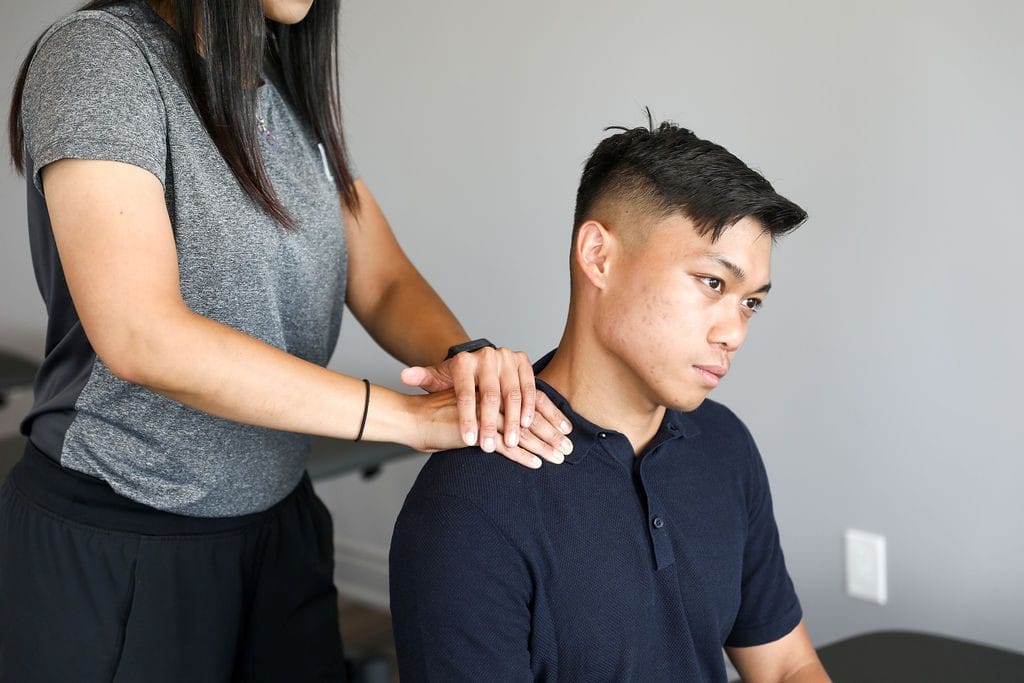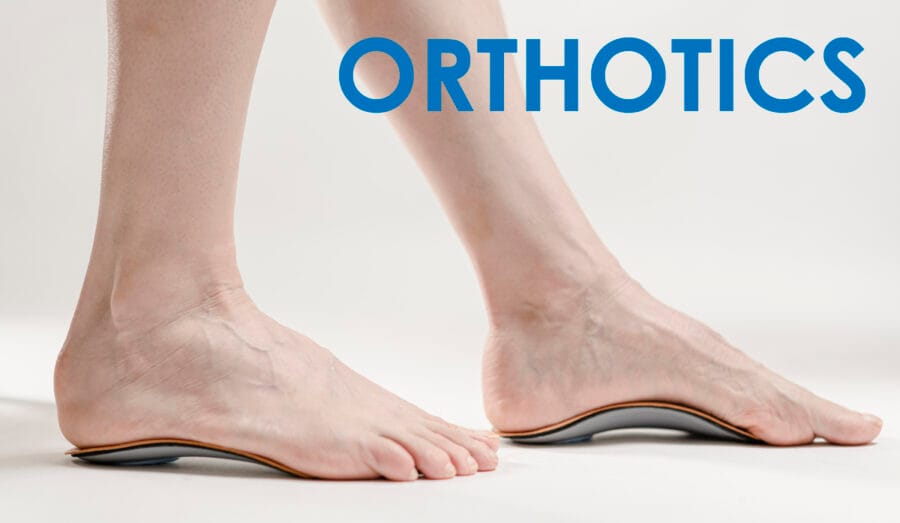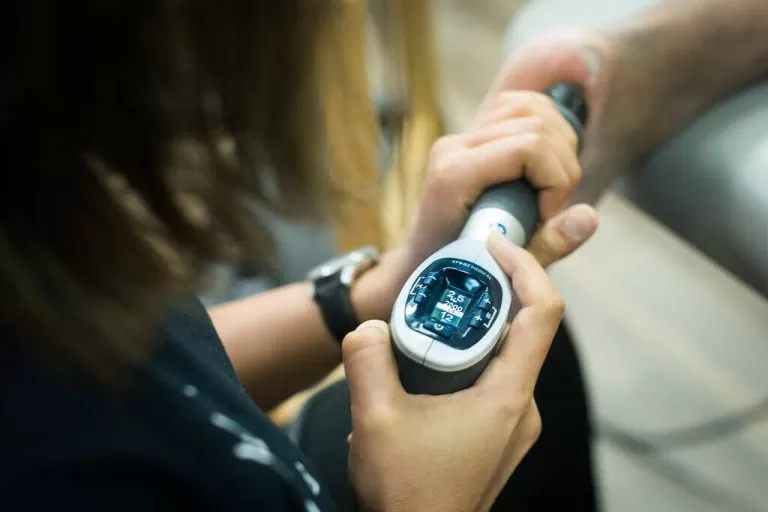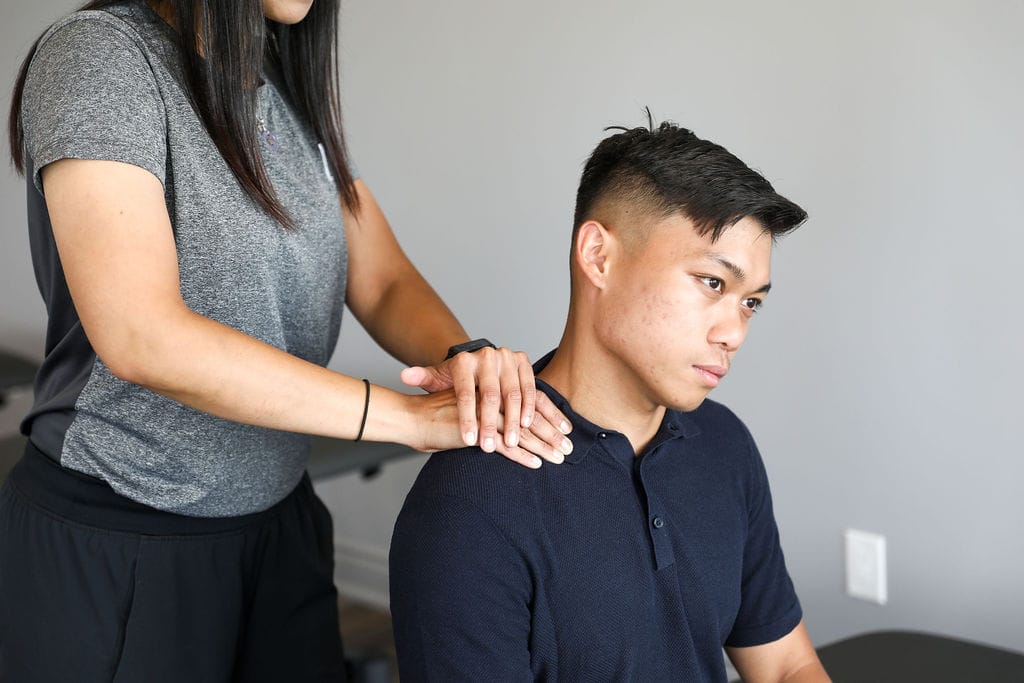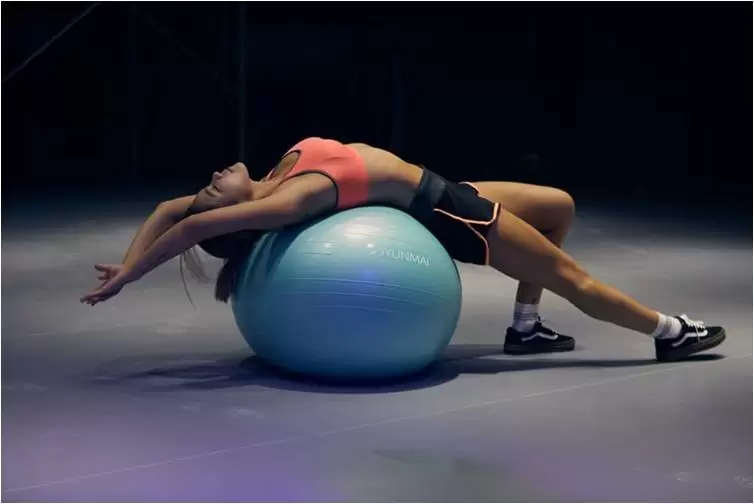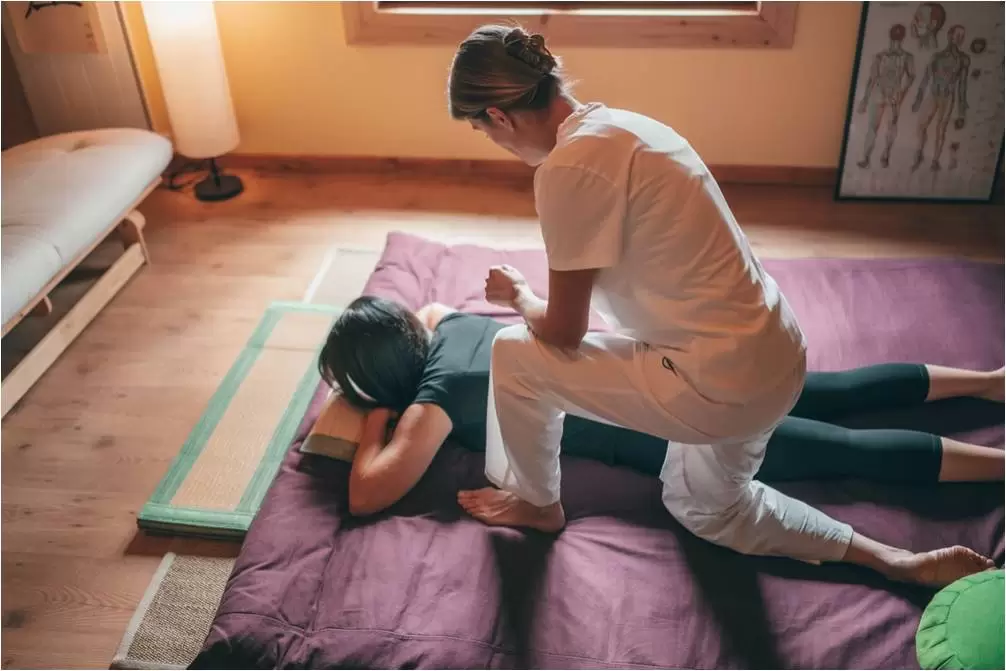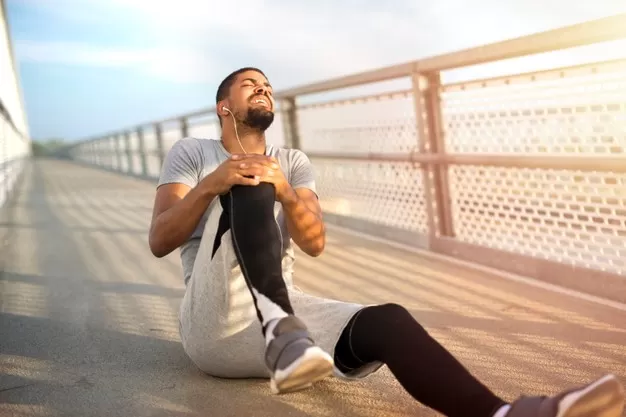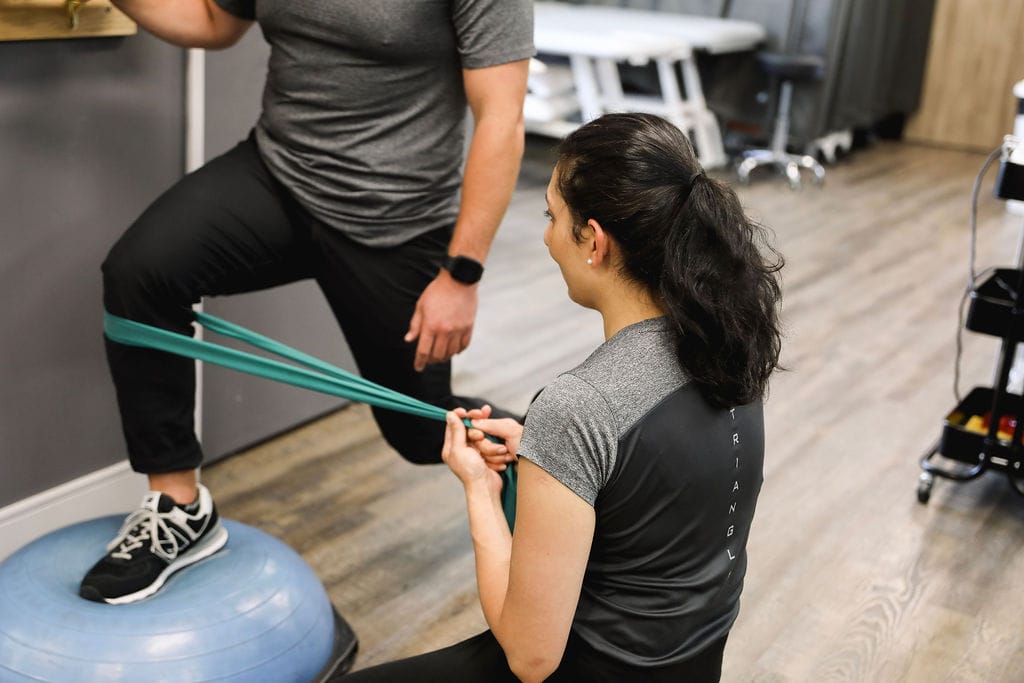
People often ask us if physiotherapy is the same as physical therapy, and the answer is yes. In fact, the term physiotherapy and physical therapy can almost be used interchangeably.
Are there any differences and similarities between physical therapy and physiotherapy?
In general, there are no differences between physical therapy and physiotherapy. The term physiotherapy is used for those based in Australia, Canada, or Ireland while the term physical therapy is used by those based primarily in the United States.
Some believe that there is a slight difference when it comes to its approach. Some would say physiotherapy uses more hands on approach and manual therapy while physical therapy is more exercise based in its approach.
Ultimately, it shouldn’t matter which term is used as long as you see someone who is registered with the College of Physiotherapists of Ontario. Find a professional who will provide you with the proper treatment and care to help you with your condition and improve the quality of your life.
At Physiotherapy Oakville, all our therapists are registered with the College of Physiotherapists of Ontario, ensuring you receive the highest standard of care. By joining Physiotherapy Oakville, you can trust that you are in capable hands, dedicated to helping you achieve optimal health and well-being. Connect with our expert team today to start your journey towards a better quality of life.
Similarities:
- Both Physiotherapy and Physical Therapy aim to help patients recover from injuries and conditions that affect their mobility and independence.
- Both professions use a variety of manual therapy techniques, exercises, and other treatments to help patients regain strength, flexibility, and range of motion.
- Both Physiotherapy and Physical Therapy are concerned with improving the quality of life for patients and helping them return to their daily activities as soon as possible.
Differences:
- Geographical Location: Physiotherapy is a term used primarily in the UK, Europe, and other parts of the world, while Physical Therapy is used primarily in the United States.
- Education: Generally, the education is no different for both titles.
- Scope of Practice: This may differ based on the country of practice but in North America the socpe remains the same.
- Specializations: Physiotherapists have the option to specialize in specific areas of practice. They can specialize in sports, women’s health, cancer rehab and pediatrics. Physical Therapists also have the option to specialize, but the options may differ depending on the country they practice in.
Our More Locations
Physiotherapy Etobicoke | Physiotherapy Oakville | Physiotherapy North York | Physiotherapy Toronto | Physiotherapy Lawrence Park | Physiotherapy Mississauga | Physiotherapy Queens Quay | Physiotherapy Mississauga Erin Mills | Physiotherapy Liberty Village
Book your appointment to see a physiotherapist here.
“While physiotherapy and physical therapy are often used interchangeably, both involve similar approaches to improving movement and reducing pain. Triangle Physiotherapy offers expert services across the GTA, including Physiotherapy in Etobicoke, Oakville, North York, Toronto, Lawrence Park, Queens Quay, Erin Mills, Mississauga, and Liberty Village. Our experienced team is here to provide personalized care tailored to your specific needs, whether you refer to it as physiotherapy or physical therapy.”
Did you know children can benefit from pelvic physiotherapy too?
Most children are dry at night by school age. Approximately, 30% of children wet the bed at 4 ½ years of age. Fecal incontinence is also common in children. If a child has regular soiling or poo accidents after the age of 4 they should be assessed.
There is no cause to worry. Pelvic Health issues in children can be resolved with the help of a trained pelvic health physiotherapist at Triangle Physiotherapy.
Common conditions experienced by children include:
Constipation: infrequent bowel movements, frequent movements with pain or difficulty
Incontinence: inability to maintain bowel or bladder function. Could be inability to make it to the bathroom in time or leakage with giggles and coughing
Bed Wetting (Enuresis): leaking urine through the night while sleeping.
Voiding issues (eg. Dysfunctional voiding & postponement): inappropriately engaging pelvic floor muscles during voiding or delaying going to the bathroom, sometimes as a result of fear or pain.
Did you know 85% of children have bed wetting or fecal incontinence because of constipation?

If your child is 5 or older and experiencing any of the above symptoms pediatric Pelvic Floor Physiotherapy can help them get back to being kids, and relieve familial stress!
Our trained therapists create a personalized treatment plan with parents and children to better target your concerns and furthermore improve your child’s overall quality of life. Treatment is always in a way that is fun and engaging for your young one.
What does a pelvic floor assessment entail?
Your physical therapist will start by taking a detailed child developmental and family history. We may also ask you to complete a bladder diary to better track your child’s voiding patterns and perform a functional assessment of their breathing. Thereafter, the physiotherapist will do a visual assessment for which the child need not undress. Sometimes, the physiotherapist will use externally placed sensors to assess the functioning of the pelvic floor muscles.
Note: An internal assessment is not performed.
What does the pelvic floor treatment entail?
- Education dietary foods/irritants, habit training, digestion, pelvic floor anatomy
- Biofeedback machines using Bluetooth to keep children engaged playing games with the aid of their pelvic floor muscles.
- Electrical Stimulation
- Toilet training
- Massage
Which locations of Triangle Physiotherapy offer Pediatric Pelvic Health in Toronto?
Pediatric Pelvic Floor Physiotherapy is offered at Triangle Physiotherapy North York, Triangle Physiotherapy Mississauga and Triangle Physiotherapy Lawrence Park.
Click here to book an appointment for your child.
Pediatric pelvic floor physiotherapy is essential for addressing bladder and bowel control issues in children. Triangle Physiotherapy offers specialized services across the GTA, including Physiotherapy in Etobicoke, Oakville, North York, Toronto, Lawrence Park, Queens Quay, Erin Mills, Mississauga, and Liberty Village. Our experienced team provides personalized care to help young patients overcome these challenges and improve their quality of life.
What is Plantar Fasciitis?
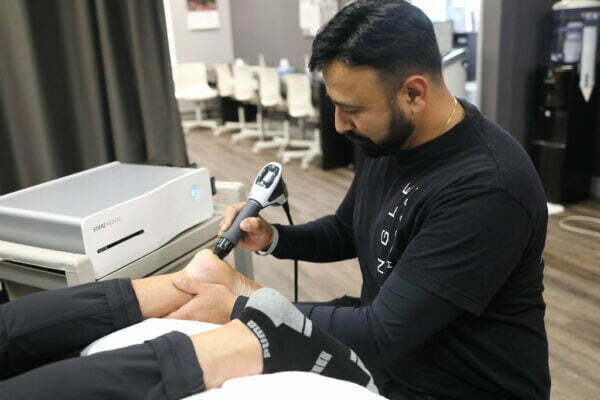
Plantar Fasciitis is a type of foot pain resulting from inflammation of a band of connective tissue located on the bottom side of the foot known as the Plantar Fascia. This band of connective tissue runs from the heel of the foot, all the way to the base of each toe, and it functions to support the arch of the foot, especially during weight-bearing.
The pain associated with Plantar Fasciitis is located on the bottom of the foot, with it often manifesting around the heel and along the inside of the foot. It is common for this pain to be at its worst first thing in the morning, and it is usually accompanied by other symptoms, such as stiffness, weakness, swelling and decreased proprioception.
What is the Plantar Fascia?
The plantar fascia is a flat band of tissue that connects your heel bone (Calcaneus) to the base of the toes (Metatarsophalangeal joints). This ligament assists in supporting the arch of your foot.
What causes Plantar Foot Pain?
People experience this when they have strained the connective tissue from repetitive overloading to the area. Repetitive overloading causes little tears to occur, and over time this produces inflammation and other associated symptoms, as described above.
Plantar Fasciitis is more common in people who can relate to the following:
- Have flat feet or high arches
- Have tight calf muscles
- Wear improper footwear
- Engage in repetitive physical activity (overtraining)
- Suddenly changed activity levels (increased frequency, duration or intensity)
- Suddenly changed activity or training environment
- Work in an environment that requires prolonged standing
Plantar Fasciitis is one of the most common reasons people experience foot pain and seek Physiotherapy treatment to solve it.
How can a physiotherapist at Triangle Physiotherapy help with plantar foot pain?
A Physiotherapist at Triangle Physiotherapy will do a thorough assessment of the fot to ensure a proper diagnosis is obtained. This will include getting a detailed history, observing the area and how you function, and running through a series of specific tests. From there, an individualized treatment plan will be made for you to help you achieve your goals and assist you on your road to recovery.
If you think you might have Plantar Foot Pain, contact us to book an appointment with one of our Physiotherapists today!
“Managing plantar foot pain effectively requires targeted physiotherapy. Triangle Physiotherapy offers expert services across the GTA, including Physiotherapy in Etobicoke, Oakville, North York, Toronto, Lawrence Park, Queens Quay, Erin Mills, Mississauga, and Liberty Village. Our experienced physiotherapists provide personalized care to help alleviate pain and improve foot function, ensuring you can get back on your feet with confidence.”
What are orthotics?
Orthotics are custom made inserts that are worn inside your shoe to control abnormal foot function.
Orthotics solve a number of biomechanically related problems, for example, ankle and knee pain, pelvis, hip, spinal pain. This is achieved by preventing misalignment of the foot, which significantly alters the way in which the bones move within their joints.
Orthotics work for the feet the same way prescription glasses work for the eyes.
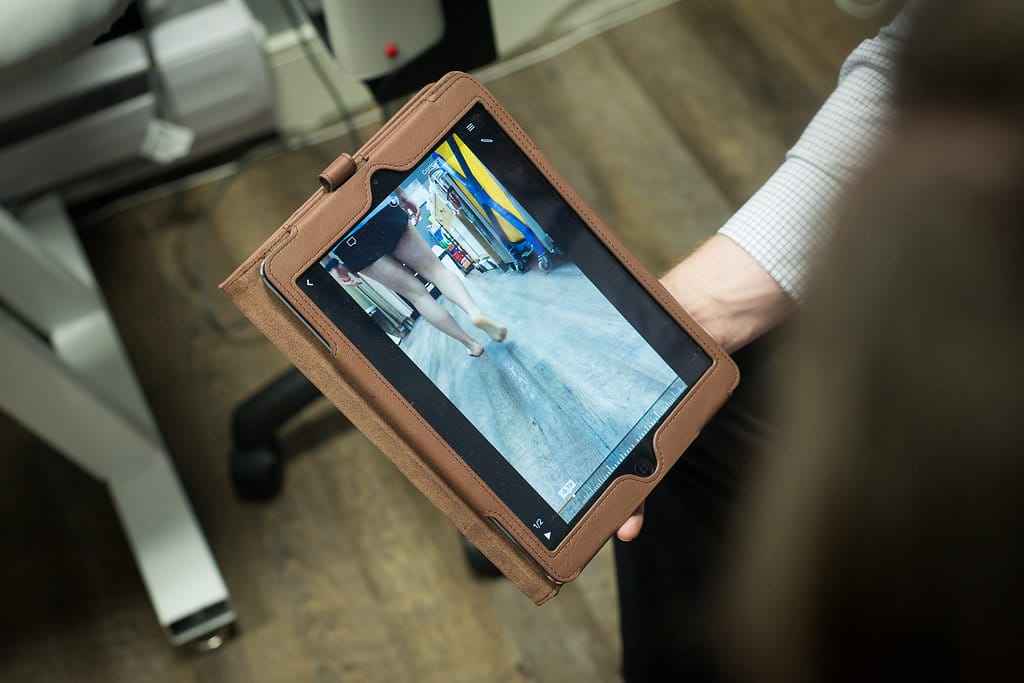
Who can benefit from orthotics?
Custom orthotics can be used for all ages and for a variety of activities and can be made to fit any type of shoe.
Where can I get the best custom orthotics?
The best custom orthotics can be purchased from a clinic where a chiropodist or qualified health professional conducts an assessment and a 3D scan of your feet to determine the best orthotics for you. The 3D Scan is then sent to a lab where the scan is used to manufacture your orthotics.
Triangle Physiotherapy has qualified health practitioners that can assess you and recommend the best custom orthotics for you.
How can Orthotics correct foot conditions?
The best custom orthotics can:
- Help balance pressure placed on the feet by redistributing the weight appropriately
- Help stabilize the heel
- Support the arch of the feet
- Provide cushioning to delicate and inflamed areas of the feet that arise from too much walking, jogging, running, etc.
What is a knee brace and how can it help me?
A knee brace can help support and stabilize an unstable knee due to injury or osteoarthritis. The best knee brace will offer the support you need in order to balance and evenly distribute your weight in order to have a more comfortable walk or run.
What conditions can a knee brace help with?
Whether it’s a knee sprain, arthritis, torn ACL, runner’s knee, knee instabilities or knee discomfort, the best knee braces help support and manage pain.
When should I start wearing a knee brace?
Once you start experiencing knee pain or discomfort or find that the knee is unstable while walking or running or after you have had knee surgery , book an appointment with one of our health practitioners who can assess you and recommend the best knee brace for you.
“Custom orthotics and knee braces can significantly improve mobility and reduce pain. Triangle Physiotherapy offers expert services across the GTA, including Physiotherapy in Etobicoke, Oakville, North York, Toronto, Lawrence Park, Queens Quay, Erin Mills, Mississauga, and Liberty Village. Our experienced team can help you find the best solutions to support your foot and knee health, ensuring a personalized approach to your treatment.”
What is Shockwave Therapy?
Shockwave Therapy is a non-invasive treatment procedure that essentially involves creating a series of short energy acoustic wave pulsations that are directly applied to an injury. It uses a pneumatic generator to physically deliver the shock wave through the skin, into the body. The short-energy acoustic waves that are transmitted through the surface of the skin are spread spherically into the body and the body responds with increased metabolic activity around the pain area. It is a fast and alternative solution to surgery.
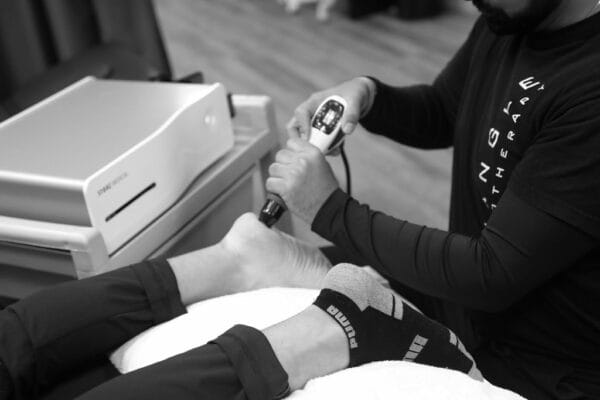
Shockwave Therapy was originally invented for the treatment of kidney stones to blast the rigid tissues into smaller pieces, making it easier to pass. After the effectiveness of that treatment was established, researchers began studying the effects of the machine at different settings and used it to treat calcific tissue and scar tissue in the body. Their findings indicate that this treatment is extremely effective for the treatment of most musculoskeletal conditions in the body.
Benefits of Shockwave Therapy
- Success rate up to 90% in the treatment of soft tissue disorders, including:
- calcific tendinitis of the shoulder,
- plantar fasciitis,
- tennis elbow, and
- piriformis muscle.
- It is an excellent cost-effective treatment
- Helpful in the treatment of chronic pain including:
- shoulder,
- back,
- heel,
- knee, or
- elbow
- No anesthesia or drugs are required
- Varied application in many fields including orthopedics, rehabilitation, and sport medicine
- Latest medical research shows that it can have a positive impact on acute pain
How does shockwave therapy work?
Shockwave Therapy is also known as extracorporeal shock wave therapy [ESWT]. It is a method that is being used more commonly in physiotherapy. Using much lower energy compared to other medical applications, it is primarily used to treat connective tissues such as ligaments and tendons.
Your physiotherapist will evaluate your condition and determine if Shockwave Therapy is appropriate for you. They will also educate you on your condition and recommend additional activities such as activity modification, tennis elbow exercises, acupuncture, massage, and posture correction to help with your healing process.
During the treatment, the therapist will direct the shockwaves into the affected area through the skin, causing no pain. The therapy is typically performed in several sessions and is a safe, non-invasive, and drug-free solution for chronic pain in the shoulder, back, heel, knee, or elbow. The latest medical research also shows that it can have a positive impact on acute pain. Shockwave Therapy is widely used in fields such as orthopedics, rehabilitation, and sports medicine.
Book an appointment for Shockwave Therapy here.
Shockwave therapy is a non-invasive treatment used to accelerate healing and reduce pain in conditions like plantar fasciitis, tendonitis, and other musculoskeletal disorders. It works by delivering high-energy sound waves to the affected area, stimulating blood flow and promoting tissue regeneration. Triangle Physiotherapy offers this treatment across various locations in the GTA, including Physiotherapy in Etobicoke, Oakville, North York, Toronto, Lawrence Park, Queens Quay, Erin Mills, Mississauga, and Liberty Village.
Should I go to a physiotherapist after a car accident?
If you met with a car accident and having problems related to the mobility of your body or if it causes obstacles to function properly and efficiently then you should definitely go for Physical Therapy.
Physical therapists are musculoskeletal experts and may help cure the underlying musculoskeletal injuries that may have occurred after meeting with a car accident. At Triangle Physiotherapy, our Physical Therapists will assure a one-to-one session where they will conduct an extensive whole-body analysis with a target of developing a customized treatment and detailed physical therapy programs which suit best to your condition and individual needs.
What can a physiotherapist do to help after a car accident?
The goal of physical therapy is to help you recover physically and strengthen damaged muscles and tissues.
A Few physical therapy exercise programs would include:
- Manual therapy to mobilize joints, decrease scar tissue, reduce inflammation and enhance healing of tissue.
- Custom exercises to address types of pain like neck and shoulder pain, back pain, spine dysfunction, or weakness.
- Postural training to resolve pain in the neck, shoulders, and back.
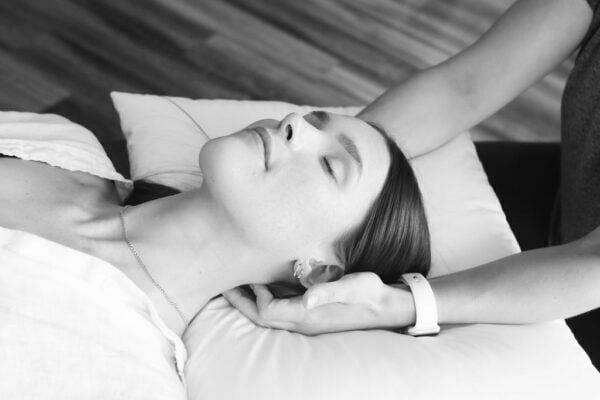
COMMON TYPES OF INJURIES
The list of injuries if you meet with a car accident are as follows:
- Whiplash
- Headaches
- Back Pain
- Neck Pain
- Shoulder Pain
- Knee Pain
What are the common symptoms related to WHIPLASH?
Common symptoms related to whiplash include:
- Stiffness to neck, arms, upper back, and the face.
- Numbness into arms, neck, and upper back.
- Headache, dizziness, nausea.
- Feelings of general weakness.
- Altered and disturbed sleeping habits and patterns.
- Difficulty with concentration.
Is it important to get physiotherapy as soon as possible after a car accident?
Although you may feel the immediate onset of pain or symptoms of injury, these symptoms may bring forth pain and mobility problems over the long haul.
Suppose if you met with a car accident, one may wonder that why is it necessary to get treated with Physiotherapy after an accident? If you’re considering Physiotherapy after a car accident, there are many reasons that you may want to begin or continue with the treatment.
The doctor will recommend that you receive Physiotherapy and you will realize the benefit of rehabilitation after a car accident. You may realize on your own that you can benefit from rehabilitative treatment.
Here’s why you should start Physical Therapy after a car accident:
- Physical Therapy After a Car Accident Can Help You Recover Faster
Going through Physical Therapy after a car accident can help you speed up your recovery time. It can help the body recover its lost strength so that you can reduce the amount of time it takes to improve and fully recover from the injuries caused by car accidents. Time and again patients don’t realize how bad their car accident injuries are until they return to their day-to-day activities.
If you are looking for a physiotherapist to help you with your injuries, our rehabilitation facility is one of the best physiotherapy clinics:
- Physical Therapy Can Help You Recover Better and Prevent Long-term damage
In order to help you recover faster, Physical Therapy programs ensure a better outcome after taking good care and following Physical Therapy exercises. It can also help you or prevent the long-term effects of your injuries like chronic pain and migraines. Unfortunately, car crashes can cause nagging damage if the patient’s injuries are not addressed right away. If you begin physical therapy immediately after your car accident, it’s more expedient to live a pain-free life for years.
- Boosting Mental Health and Improving Quality of Life
Some issues can create a problem after years of being a victim of a car accident and this can seriously affect the quality of life of a person. Physical therapy relieves these issues before becoming a serious health concern for an individual.
- Avoiding Surgery
Every so often injuries caused by car accidents can even require surgery, most injuries or a type of wear and tear but a few injuries, if left rampant, can lead to surgery and costly hospital bills. It is always advised to immediately check-up with a professional for the treatment. This will help with any claims you may wish to make later on. Physical therapy treatment is a much more cost-effective solution to recovery.
There are multiple benefits of physiotherapy and that’s why people are opting for this line of treatment for recovery and overall well-being.
Steps to take after a car accident and a few advantages of Physiotherapy:
- The Type of Injury
Car accident injuries can affect your recovery time and the time period that takes to complete your treatment. One of the most common car accident injuries is whiplash. A whiplash injury occurs when the force of the accident causes your head and neck to jerk violently forward and backward. This can cause the muscles and tendons in your neck to stretch outside their normal range of motion. Whiplash can also affect the spinal column in your neck and disc injuries can be serious. Depends on the intensity of the whiplash, it can take a few months to recover and get the accurate motion of the neck as it was before.
2. The Severity of the Accident
It is more likely to sustain a moderate to severe injury in a more serious car accident, even the smallest of the injury. A more severe accident can cause consequential harm to your body even if you are taking all precautions of car safety like wearing the seatbelt and the airbag deploys. More serious injuries like a dislocated knee or a broken foot can impact your daily routines.
3. Any Previous Injuries
A previous injury can leave behind scar tissue, that impacts how your body heals the new injury. Physiotherapy often takes longer if you have previous injuries, especially if they occur in the same area.
Few factors that effect are:
- The severity of the injury
- Location of the injury
- Patient’s current state of health
- Patient’s treatment goals
- Rate of progress
How can Physiotherapy help if you’ve met with a car accident?
Physiotherapy helps reduce the pain and discomfort usually felt after a car accident injury. A lack of physical activity when recovering from an injury can actually cause stiffness, which can lead to more discomfort when trying to return to your daily activities, so you should always try to keep your body in motion.
“Recovering from a car accident requires targeted physiotherapy to restore mobility and reduce pain. Triangle Physiotherapy offers expert care across the GTA, including Physiotherapy in Etobicoke, Oakville, North York, Toronto, Lawrence Park, Queens Quay, Erin Mills, Mississauga, and Liberty Village. Our experienced team provides personalized rehabilitation plans to help you recover effectively and regain your quality of life.”
Derived from the Greek word spondylo means spine and listhsis stand for slipping down a slippery path. Spondylolisthesis is a disorder of the spine that results in a forward or backward slippage of one vertebra on an adjacent one. Spondylolisthesis usually happens in the lower back region, also known as the lumbar area. Spondylolisthesis has an adverse impact on the daily lifestyle and therefore it is suggested to visit a good physiotherapist in such a condition. You can visit our Physiotherapy clinics in GTA to reduce the pain and impact of Spondylolisthesis.
Types of Spondylolistheses
Spondylolisthesis can be categorized into five major types –
1. Isthmic Spondylolisthesis – This is caused by a defect in pars interarticularis – a part of the vertebra. This condition usually leads to the vertebrae slipping forward.
2. Degenerative Spondylolisthesis – This condition is usually caused when the joints lose their capacity to keep the spine alignment at the normal position. This may result in the vertebrae slipping forward.
3. Congenital Spondylolisthesis – Congenital health issues are the ones that are present in a person since birth. Sometimes there is an abnormal formation of spinal bones during pregnancy at the time of development of the baby. Here the spinal discs slip due to misalignment and malformation.
4. Traumatic Spondylolisthesis – This is caused as a result of any injury or trauma leading to slipping of the spinal discs. It is important to note that here the term traumatic indicates an injury causing damage to the spinal discs.
5. Pathologic Spondylolisthesis – This disorder is a result of a disease affecting the healthiness of the spinal bones thereby weakening the same. Diseases like osteoporosis can cause Pathological Spondylolisthesis.
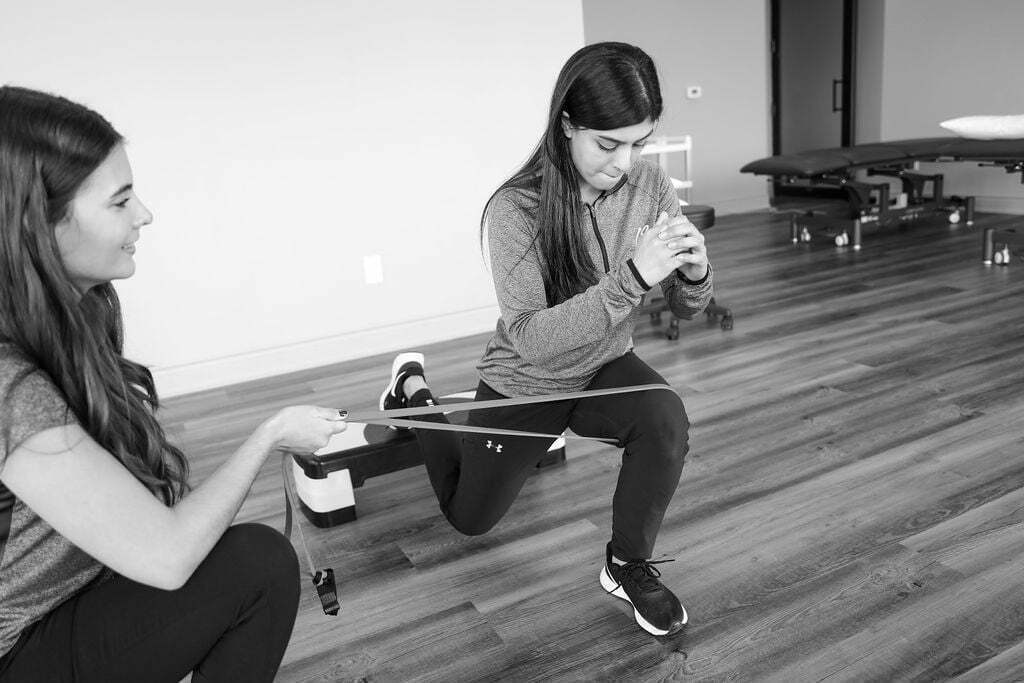
Causes of Spondylolisthesis

Physiotherapy and Physiology both have many similarities, but they have a set of differences too.

What is Physiotherapy and what does a physical therapist do?
Physiotherapy or Physical Therapy is a medical treatment where patients face problems of mobility, function, and well-being; pain in specific locations of a body especially body parts that are in constant motion like bones, tissues, etc. it helps through physical rehabilitation, injury prevention. Tests are carried out to determine the limitations of the patient which further helps in formulating the set of exercises that will aid in restoring movement.
Physiotherapist duties are:
- Detect the patient’s medical issues in order to help the patient recover from illness, accident, or injury.
- Provide a clear and well-organized exercise program with clearly defined goals and milestone targets.
- Set objectives for patient progress and document it.
- Set up an exercise session as a part of the treatment, and maintain detailed reports of future exercise planning.
- Prepare an evaluation document, and instruct patients to use exercise equipment such as walkers.
- Inform the patient about the benefits of exercise to mentally motivate them.
- Follow the doctor’s directions to prescribe exercises meanwhile assisting doctors and nurses if required.
What is Physiology and what does a Physiologist do?
Physiology is a medical treatment and a detailed study of the anatomy of the body’s organs and their cells, this treatment aims at preventing chronic diseases and providing physical health benefits suffering from injuries. It treats diseases like obesity, cardiovascular diseases, and diabetes.
Physiologist responsibilities are:
- Monitor and record patients’ health and medical performance while exercising and under medication, and make thorough observations over time to deliver results to the physician.
- Use medical equipment and machinery when going through the exercise of the lungs and heart.
- Performing tests to evaluate physical and mental stress levels.
- Simultaneously work with physiotherapists to evaluate results.
- Create a plan of types of exercises to be followed.
- Assess the treatment’s effectiveness to fetch the right results.
Differences between Physiologist and Physiotherapist
- Physiologists and exercise physiologist degree requirements both undertake 4 years of university training, both theoretical and practical, studying subjects such as anatomy, physiology, and biomechanics, etc. Both are recognized by Medicare, TAC, WorkCover, and private health funds, and require yearly professional development.
- Physiologists provide prescriptions and teach trigger point therapy and self-massage techniques, using exercise equipment such as foam rollers and trigger point balls. Physiotherapists, on the other hand, can deliver soft tissue mobilization through massage, acupuncture, dry needling, and ultrasounds, and guide you through self-massage techniques as well.
- Physiotherapists evaluate the injury diagnosis and prognosis, whereas Physiologists receive the injury diagnosis and deliver the rehabilitation prognosis.
- Physiologists specialize in providing lifestyle modification techniques to support those with a wide range of chronic health conditions to promote improved health and wellness and decrease risk. Physiotherapists will overall specialize in the acute phase of an injury, and can often also deliver long-term rehabilitation and health monitoring.
- Exercise physiology accreditation and the conditions they work with:
- Cancer treatment recovery
- Chronic pain and fatigue
- Managing osteoarthritis pain
- Osteoporosis and arthritis
- Diabetes
- Metabolic Syndrome
- Mental health
- Musculoskeletal
- Neurological (Parkinson’s disease, multiple sclerosis, cerebral palsy)
- Obesity
- Pulmonary
- Cardiovascular
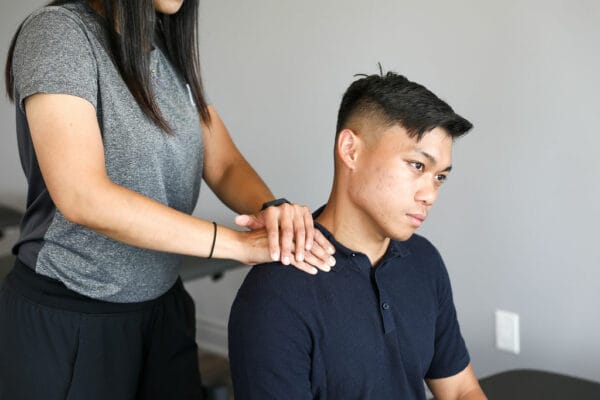
6. Conditions physical therapists work with:
- Mobility and balance concerns/falls
- Back or other spinal joint pain
- Sports injuries
- Chronic pain
- Post-surgery rehabilitation
- Cardiorespiratory issues
- Neurological (injuries) conditions – for example, stroke
- Parkinson’s disease
- Multiple Sclerosis
- Arthritis- for example osteoarthritis/rheumatoid arthritInjury Cycle – Acute Phase
Injury Cycle – Recovery Phase
The next phase of rehabilitation that is 3 to 4 weeks post-injury, is when a Physical Therapist will come into the play and provide treatment in order to introduce exercises to regain range of movement, including mobilization of soft tissue structures, and restore joint mobility and strength to optimize function.
All exercises prescribed by the Exercise Physiologist are made to achieve each individual’s activities of daily living and rehabilitation or performance goals.
Exercises recommended by Physical Therapists are made to achieve an individual’s daily life activities and rehabilitation or performance targets.
Difference between Physiology and Physiotherapy
| Physiotherapy | Physiology |
| Disorders concerning muscle and bones are treated by physiotherapy. This includes some medical conditions such as arthritis, joint aches, back pain, cardiorespiratory ailments like emphysema, asthma, neurological disorders like Parkinson’s disease, stroke, and post-surgery complications, etc. | Physiology focuses on increasing metabolism and physical energy during the course of treatment along with rehabilitation. The diseases treated by physiological exercises are obesity, hypertension, diabetes, immunity complexities, arthritis, etc. |
| The techniques used by Physiotherapy are manipulation, electrotherapy, mobilization, therapeutic physiotherapy exercises, and gentle massage. These are performed by trained physiotherapists after evaluating the patient’s physical conditions. | Physiological treatments are not rendered after identifying the problem. The treatment to lower any kind of discomfort before a proper diagnosis is a part of physiology exercises. In physiology, a proper plan is designed with the mainstream treatment and changes in lifestyle and behavior. |
| Physiotherapy can be studied at the Bachelors’s level (BPT) course. | Physiology is a higher academic course at the Post Graduate level of medical science. One has to complete MBBS before opting for MD in Physiology. |
Why do you need a Physiotherapist and how can they help you?
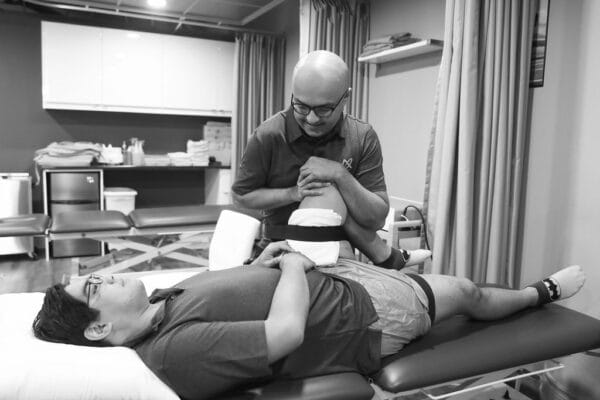
Using these checklists is a great way to decide which health professional is best for you.
- Do you have pain that is new, unexpected, or not yet diagnosed?
- Or you have a type of sports injury, or have you recently undergone orthopedic surgery?
- Do you require hands-on treatment for symptomatic relief such as acupuncture, manipulation or massage?
If you have answered yes to any of the above questions, then a Physical Therapist may be for you!
It’s well known that exercising for the proper duration and intensity may help improve the quality and length of life – it may decrease the incidence of obesity and chronic health conditions. Accredited Exercise Physiologists can work with such conditions through prescriptions and proper training.
Our Exercise Physiologists are university-qualified health professionals who provide safe, effective exercise programs, tailor-made to meet your health goals.
Do you need a physiologist and a physiotherapist and how can they help you?
Using these checklists is a great way to decide which health professional is best for you.
- Are you recovering from an injury, or have a prior injury that you do not want to worsen, however, wish to get fit and healthy?
- Do you have a chronic health condition (such as diabetes, hypertension, high cholesterol, asthma, obesity, osteoporosis, etc.) that exercise could assist with?
- If you have goals around losing weight or maintaining a healthy weight?
- Do you seek a specifically drafted and prescribed exercise program that will meet your health and wellness needs?
At the end of the day, there is a degree of overlap between both professions as they aid in treating many different conditions and aspects of health and well-being. The key takeaway is to choose the right professional based on your stage of recovery. If you are in the acute stages of rehabilitation, a physiotherapist is the ideal person to seek treatment from. However, if you are in the sub-acute, recovery, or chronic stage of rehabilitation, receiving treatment from an expert physiologist who can provide a specific and individually tailored exercise program is what you need.
At Physiotherapy Oakville, our team collaborates with both physiotherapists and physiologists to ensure you receive comprehensive care at every stage of your recovery. Scientific evidence supports the importance of tailored treatment plans in achieving optimal health outcomes. By joining Physiotherapy Oakville, you benefit from a multidisciplinary approach that addresses your unique needs, ensuring effective treatment and a smooth recovery process.
Click HERE to book an appointment with a physiotherapist at one of our eight locations.
- Physiotherapy Etobicoke – Triangle Physiotherapy Etobicoke
- Oakville Physiotherapy Clinic – Triangle Physiotherapy Oakville
- Physiotherapy North York – Triangle Physiotherapy North Yor
- Mississauga Physiotherapy Clinics – Triangle Physiotherapy Mississauga
- Downtown Physiotherapy Clinics – Triangle Physiotherapy King West
- Uptown Physiotherapy Clinics – Triangle Physiotherapy Lawrence Park
- Physiotherapy Clinic Downtown Toronto – Triangle Physiotherapy Queens Quay
- Physiotherapy Clinics Mississauga – Triangle Physiotherapy Erin Mills
“Understanding the differences between a physiologist and a physical therapist is crucial for choosing the right care for your needs. Triangle Physiotherapy offers expert services across the GTA, including Physiotherapy in Etobicoke, Oakville, North York, Toronto, Lawrence Park, Queens Quay, Erin Mills, Mississauga, and Liberty Village. Our skilled physiotherapists are here to provide personalized treatment plans tailored to your specific health goals.”
Importance of Physiotherapy Exercises
Physiotherapy exercises have a major role to play in the recovery plan for any injury or accident. It is directed towards specific objectives like restoring muscular and skeletal function, increase circulation, reduce muscle spasms and improve overall strength and well-being. Gone are the days when a patient was told to just rest for two or three weeks, sometimes even long after an injury. Advanced physiotherapy exercises are now a part of the treatment plan and have in fact become an important modality in managing musculoskeletal conditions. These days, Physiotherapy exercises constitute a huge part of the recovery plan post any injury or trauma. You can consult our specialized Physiotherapy services in GTA.
Reasons to include exercises in your recovery
There are various reasons why you should include Physiotherapy exercises in your recovery plan. Here are the reasons you should have to keep moving for better recovery and overall strength –
- Reduces or eliminates pain – Physiotherapy exercises like joint or soft tissue mobilization helps in reducing pain and restoring joint and muscle function. It also helps in preventing the pain from returning.
- Avoids surgery – There are instances when physiotherapy exercises can eliminate the pain and heal the injury, thereby avoiding the surgery and its associated risks.
- Improves mobility – Irrespective of age or gender, mobility issues like standing, walking, or moving can hit anyone. Strengthening and stretching exercises in Physiotherapy helps in restoring the ability to move.
- Recovery from a sports injury – A good physiotherapist understands how different sports can increase the chances of sports injury and therefore, they can lay out an appropriate recovery plan based on your injury and medical condition.
- Improves balance and prevents fall – Physiotherapy assesses your vulnerability to falls and associated risks. Your physiotherapist will provide appropriate physiotherapy exercises to improve balance and coordination for safe walking.
- Manages diabetes and vascular conditions – Physiotherapy exercises can be a part of the overall diabetes management program. People suffering from diabetes face troubling sensation in feet and legs. They can be benefitted from physiotherapy exercises in ensuring proper foot care.
- Manages age-related issues – As a person ages, he/she may develop complications like arthritis, osteoporosis or joint replacement. Physiotherapy exercises can help patients recover from such age-related disorders.
- Recovery from a stroke – Many people experience losing some degree of function and movement after stroke. Physiotherapy exercises help in strengthening the weakened body parts and improve strength and balance. Your physiotherapist will also work in improving your ability to move around so that you can be more independent at home and take care of yourself without being dependent on anyone.
- Manages heart and lung diseases – After a heart attack, though the patient may complete cardiac rehabilitation, he/she may need physiotherapy if the daily functioning is affected. Physiotherapy exercises also help in improving lung capacity through breathing exercises, conditioning, strengthening, and clearing the fluids in the lungs.
- Improves women’s health and other conditions – Women face specific health conditions like pregnancy and post-partum care. Physiotherapy exercises for women help in managing specialized issues related to women’s health. Physiotherapy also provides specific treatment for medical conditions like breast cancer, bowel incontinence, constipation, lymphedema, fibromyalgia, etc.
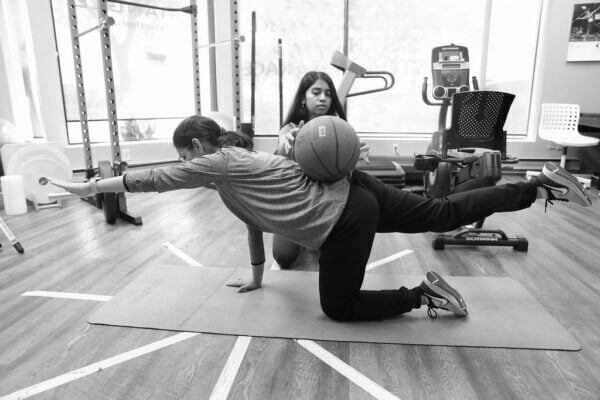
Physiotherapy Oakville offers a host of services to help you recover from injury or medical conditions. You can visit our clinics in the GTA for your specific requirements or consult our physiotherapists online through a secure video conference platform from the comfort of your home or office.
Based on your condition, our physiotherapist will develop a detailed and personalized program targeted to your needs. This program will include various physiotherapy exercises aimed at addressing the difficulties you experience. Joining Physiotherapy Oakville ensures you receive tailored care that fits seamlessly into your lifestyle, promoting effective recovery and overall well-being. Connect with us today to start your personalized physiotherapy journey.
Physiotherapy exercises have two main objectives
- Lubricate joint surfaces
- Maintain and increase range of motion
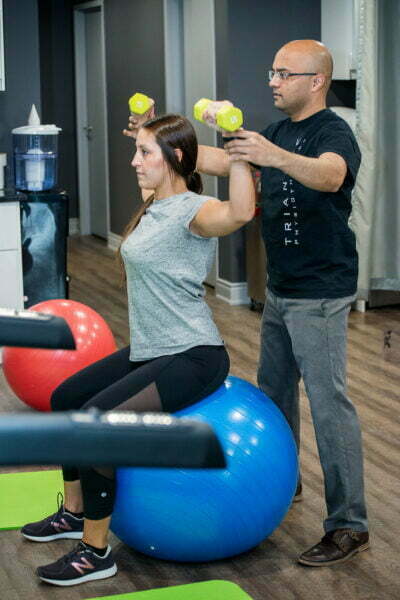
There are various types of physiotherapy exercises that help in achieving both of these objectives.
Musculoskeletal physiotherapy
- Also known as orthopedic physiotherapy, this treatment falls under the category that aims to restore the functioning of the musculoskeletal system, including muscles, joints, ligaments, tendons, and bones. Musculoskeletal physiotherapy focuses on –
- Reducing pain
- Correcting skeletal alignment
- Treating damage in soft tissues
- Improving mobilization
Geriatric physiotherapy
Focusing on older adults, this branch of physiotherapy exercise caters to specific needs that occur during old age. As people grow older, they experience disorders like arthritis, cancer, joint replacement, Alzheimer’s, osteoporosis, and balance disorders. The main goals of geriatric physiotherapy are –
- Reducing pain
- Restoring mobility impacted by old age
- Improving overall wellbeing and physical fitness
- Helping inactive aging
Sports physiotherapy
- This niche branch of physiotherapy exercise includes management of athletic and sports injuries through –
- Initial diagnosis and assessment of sports injury
- Treatment of the injury through personalized advice and techniques to promote healing
- Ensuring a quick return to the sport through rehabilitation and progressive injury management
- Advice on preventive practices like movement assessment to identify and address the known precursors to the injury
- Sharing specialized knowledge to sportsperson or athletes like taping technique to aid in the prevention of injury in future
Women’s Health
- Physiotherapy for women is a very specific area and requires particular physiotherapy exercises to address health issues faced by women. These include childbirth, prenatal, postnatal care, fertility issues, etc. Physiotherapy exercises for women focus on –
- Strengthening the core
- Reducing lower back, hip, and pelvic pain experienced during and after pregnancy
- Controlling urinary incontinence
- Activating pelvic floor
- Decreasing lymphatic swelling
- Prenatal and postnatal care
Rehabilitation and pain management
This can be divided into two categories –
- If you are experiencing chronic pain and are planning to go for surgery then this physiotherapy exercise would help you in relieving pain.
- Treatment before the surgery helps in strengthening the body and preparing it for post-operative rehabilitation.
Neurological physiotherapy
This range of physiotherapy exercises focuses on disorders affecting the nervous system like head injuries, stroke, damage in the spinal cord, sciatica, multiple sclerosis, Parkinson’s disease, and issues related to vertigo. Here the treatment focuses on –
- Correcting neural pathways
- Motor control
- Balance and coordination
Your physiotherapist will suggest the exercises depending upon the stage of your recovery. Range of Movement (ROM) exercises are commonly suggested forms of exercise in physiotherapy. These exercises are advised for a specific joint where there is a reduced amount of movement. There are three types of Range of Movement exercises.
- Passive Range of Motion Exercise (PROME) – Here, the physiotherapist moves the limb along the joint range. It is mostly performed on patients who cannot move their limbs.
- Active – Assistive Range of Motion Exercises (AAROME) – This Range of Motion Exercise is performed on patients who can move their limbs but need assistance to complete the joint range. Here the role of the physiotherapist is very important as he helps the patient to complete the movement and ensure that the pain is not worsened.
- Active Range of Motion Exercise (AROME) – Here, the patient performs the physiotherapy exercises without any physical assistance from the physiotherapist. Though the physiotherapist suggests and instructs the proper execution of the exercise, the patient performs all the exercise by himself.
If you feel or experience any pain in the body, please contact us and speak to our skilled and experienced physiotherapists for an expert opinion.
When it comes to patient care, it is important to understand the different severities of injuries. This classification is important as it helps the medical practitioners to address and prioritize the efforts. Here, we are going to talk about the difference between injury and trauma and help you understand how does physiotherapy help in the treatment of both.
Unfortunately, the injuries caused due to trauma are very severe and require need complex medical treatment and longer recovery time. Therefore, anyone who undergoes a traumatic injury must consult the experts for their condition and avail the best physiotherapy treatment to ensure maximum and fastest recovery.
What is an injury?

What Is An InjuryIn simple terms, any instance that causes harm to the body can be classified as an injury. Injuries can be divided into different ranges, depending upon the severity and impact on the body. Some injuries might require immediate medical attention while some can heal naturally with minimum or less care. Some examples of injuries are cuts, burns, scrapes, minor concussions, broken bones and sprains. What may look like a minor injury could require urgent and special medical care. Therefore, it is suggested to visit a trained and experienced physiotherapist or practitioner in case of an injury.
What is a trauma?
Trauma can be explained as a more serious, possibly life-threatening injury, requiring urgent medical attention. A trauma is a critical injury and therefore most hospitals have a trauma center to attend and treat sensitive and urgent cases like these. Some of the examples of the trauma includes road accidents, severe cuts, burns, blunt-force trauma, serious falls, multiple broken bones, head injury, major concussions or stab wounds. Though the minor cuts or wounds can be handled by an effective first-aid kit or stitches, serious trauma like burns, bleeding artery or head injury may require extensive surgery followed by rehabilitation for a proper recovery.
Physiotherapy and Injury
When it comes to the recovery stage, physiotherapy is extremely beneficial. Many people believe that the road to recovery in injury passes through physiotherapy and the recovery can never be complete without physiotherapy. If a person has suffered from an injury from a broken bone or a sprained limb, he will face major challenges in routine activities. Simple tasks like walking or driving can be become arduous. This is where physiotherapy comes into picture. Physiotherapy provides the direction to exercise and mobilize specific muscles and tissues so that the body heals from the injury.
If a person suffers from an injury – major or minor, it is suggested that he should consult with the doctor about the recovery plan that must include physiotherapy. It is important to note that even a minimal physiotherapy helps in regaining strength and functionality post the injury. Injury recovery is not possible with a focused and dedicated physiotherapy program. For cases involving broken bones or sprains, physiotherapy is very useful to stretch and comfort the affected area and expedite the healing. Preventive physiotherapy is also beneficial for elderly patients and people at risk of injury. It helps in ensuring and maintaining balance, strength, agility and a complete range of motion while preventing injuries.
Physiotherapy and Trauma
Trauma injuries usually require more extensive and immediate surgery to fix the damage. Traumatic cases have extensive long recovery process. Patients suffer mental and physical anguish in injuries involving surgery. Based on the extent and severity of the injury, the recovery process may be anywhere from a few days to several years. In some unfortunate cases, some patients are never able to recover despite optimal surgery.
The time immediately after the injury and the subsequent surgeries is the most crucial one for people who have suffered a big physical trauma. It is this period that plays one of the biggest deciding roles in the duration and pace of the recovery. Therefore, it is suggested to consult an experienced and trained medical practitioner for the injury. Based on the injury and medical history, the doctor/medical practitioner prepares a recovery plan which starts immediately and involves a comprehensive active recovery like physiotherapy. Physiotherapy can be a painful and difficult process, but helps in regaining strength and mobility post traumatic injuries. They are a part of the recovery process in complicated cases like brain injuries and physical trauma.
Physiotherapy in GTA
Physiotherapy and rehabilitation care services can come in various forms based on the severity of the injury and medical history of the patient. For example, someone suffering from Tennis Elbow or Stress Fracture may need Shockwave Therapy Treatment, while someone who gets a head injury might need Vestibular Rehabilitation to cure dizziness and provide stability and balance to the mind. It is important to know that every situation is unique in its own way and therefore needs a different recovery plan and timeline. That is why one should be patient and adhere to the recovery plan chartered by the physiotherapist to get optimal results. At Triangle Physiotherapy, we offer a host of services aimed to provide relief from the pain and ensure preventive care for overall strength and well-being. Some of our services include –
- Pelvic Floor Physiotherapy – To encourage patients to successfully treat pelvic issues
- Vestibular Rehabilitation – To improve balance and reduce problems related to dizziness
- Shockwave Therapy – To reduce pain and promote healing shock waves are delivered to the injured soft tissues
- Chiropody – To lower the pain in the lower limbs and feet and cure mobility issues and infections
- Chiropractic – To treat the muscles, joints, bones and nerves through a non-invasive and conservative approach
- Naturopathic Medicine – To treat the root cause rather than covering up the symptoms using non-pharmacological interventions
- Massage Therapy – To promote deep relaxation, release tension and provide optimal well-being by working on the superficial and deep tissues
- Custom Bracing – To increase joint stability, improve alignment and reduce excessive movements
- Acupuncture – To help the body heal naturally by activating trigger points to relive muscle tightness
- Fascial Stretch Therapy – To achieve optimal strength, flexibility, performance and pain relief using table-based assisted stretching exercises
At Triangle Physiotherapy, we our trained and experienced physiotherapists will work with you to provide a comprehensive recovery program based on your conditions and medical history. Our services are tailor-made to provide relief and assistance to any type of injury or trauma and we ensure that you get the best recovery following our program. Our patients are our topmost priority and all our efforts are directed at providing them care and relief.
Click HERE to book an appointment with a physiotherapist at one of our eight locations.
- Physiotherapy Etobicoke – Triangle Physiotherapy Etobicoke
- Oakville Physiotherapy Clinic – Triangle Physiotherapy Oakville
- Physiotherapy North York – Triangle Physiotherapy North York
- Mississauga Physiotherapy Clinics – Triangle Physiotherapy Mississauga
- Downtown Physiotherapy Clinics – Triangle Physiotherapy King West
- Uptown Physiotherapy Clinics – Triangle Physiotherapy Lawrence Park
- Physiotherapy Clinic Downtown Toronto – Triangle Physiotherapy Queens Quay
- Physiotherapy Clinics Mississauga – Triangle Physiotherapy Erin Mills
If you are dealing with an injury or trauma, seeking professional physiotherapy can help you recover safely and effectively. Whether you’re located in physiotherapy Etobicoke, Oakville, North York, Toronto, Lawrence Park, Queens Quay, Erin Mills, Mississauga, or Liberty Village, there are physiotherapy clinics available to provide specialized care and personalized treatment plans to support your recovery journey.

